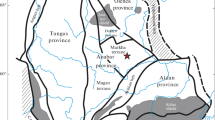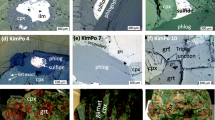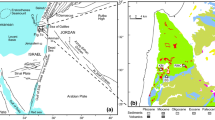Abstract
Petrographic, petrological and geochemical data for 16 mafic meta-igneous, granulite facies lower crustal xenoliths from the East Eifel were collected in order to develop a model for the lower crustal history for this region. The xenoliths consist of plagioclase±amphibole±clinopyroxene±garnet±orthopyroxene±scapolite + opaque minerals±apatite±rutile±zircon. Garnet has reacted to a variable extent with plagioclase and clinopyroxene to form a corona of plagioclaseII+ amphibole + orthopyroxeneII. Pyroxenes and plagioclases show complex zoning patterns with regard to Al and Ca which can be interpreted in terms of P, T history. Decreasing temperature and pressure conditions are recorded by decreasing Al in clinopyroxene rims coexisting with increasing anorthite contents in plagioclase rims and the breakdown of garnet. In addition, a young heating event that affected the granulites to different degrees is inferred from the complementary Ca-zoning patterns in clino- and orthopyroxenes. Rare earth element (REE) patterns of whole rocks together with the trends displayed and fractionated liquids. REE analyses of the mineral separates display equilibrium partitioning patterns for amphibole and clinopyroxene, although isotopic data show that amphibole contains externally-derived Sr and Nd components not recognized in other minerals. At least a 4-stage history for the granulites is recorded: (1) intrusion and crystal fractionation of basaltic magmas in the lower crust, probably accompanied by crustal assimilation, (2) granulite facies metamorphism, (3) a decrease in temperature and pressure, and (4) a later heating event. The complicated thermal history is reflected in Sm−Nd mineral isochron ages which range from about 170 Ma down to about 100 Ma and cannot be assigned to distinct geological events. These ages correlate with inferred temperatures; the low ages are measured for xenoliths with the highest temperatures. In some cases the young heating event is likely to be responsible for partial resetting of the mineral isochrons.
Similar content being viewed by others
References
Battacharya SK (1971) An evaluation of the chemical distinctions between igneous and metamorphic orthopyroxenes. Am Mineral 56:499–506
Boynton WV (1984) Cosmochemistry of the rare earth elements: meteorite studies. In: Henderson P (ed) Rare earth element geochemistry. Elsevier, Amsterdam, pp 63–114
Cawthorn RG, Collerson KD (1974) The recalculation of pyroxene end-member parameters and the estimation of ferrous and ferric iron content from electron microprobe analyses. Am Mineral 59:1203–1208
Cohen AS, O'Nions RK, Siegenthaler R, Griffin WL (1988) Chronology of the pressure—temperature history recorded by a granulite terrain. Contrib Mineral Petrol 98:303–311
Downes H, Leyreloup A (1986) Granulitic xenoliths from the French Massif Central-petrology, Sr and Nd isotope systematics and model age estimates. In: Dawson JB, Carswell DA, Hall J, Wedepohl KH (eds) The nature of the lower continental crust. Geol Soc Spec Publ 24, pp 319–330
Drake MJ (1975) The oxidation state of europium as an indicator of oxygen fugacity. Geochim Cosmochim Acta 39:55–64
Ellis DJ, Green DH (1979) An experimental study of the effect of Ca upon garnet-clinopyroxene Fe−Mg exchange equilibria. Contrib Mineral Petrol 71:13–22
Esperanca S, Garfunkel Z (1976) Ultramafic xenoliths from the Mt. Carmel area (Karem Maharal Volcano), Isr Lithos 19:43–49
Griffin WL, Wass SY, Hollis D (1984) Ultramafic xenoliths from Bullenmerri and Gnotuk Maars, Victoria, Australia: petrology of a subcontinental crust-mantle transition. J Petrol 25:53–87
Griffin WL, O'Reilly SY (1986) The lower crust in eastern Australia: xenolith evidence. In: Dawson JB, Carswell DA, Hall J, Wedepohl KH (eds) The nature of the lower continental crust. Geol Soc Spec Publ 24, pp 363–374
Griffin WL, O'Reilly SY (1987) The composition of the lower crust and nature of the continental Moho-xenolith evidence. In: Nixon PH (ed) Mantle xenoliths. Wiley, Chichester, pp 413–420
Hamm HM, Vieten K (1971) Zur Berechnung der kristallchemischen Formel und des Fe3+-Gehaltes von Klinopyroxenen aus Elektronenstrahl-Mikroanalysen. Neues Jahrb Mineral Monatsh 1971:310–314
Harley SL (1984a) The solubility of alumina in orthopyroxene coexisting with garnet in FeO−MgO−Al2O3−SiO2 and CaO−FeO−MgO−Al2O3−SiO2. J Petrol 25:665–696
Harley SL (1984b) Comparison of the garnet-orthopyroxene geobarometer with recent experimental studies, and applications to natural assemblages. J Petrol 25:697–712
Harley SL, Green DH (1982) Garnet-orthopyroxene barometry for granulites and peridotites. Nature 300:697–701
Jan MQ, Howie RA (1980) Ortho- and clinopyroxenes from the pyroxene granulites of Swat Kohistan, northern Pakistan. Mineral Mag 43:715–726
Kay RW, Kay SM (1981) The nature of the lower continental crust: inferences from geophysics, surface geology, and crustal xenoliths. Rev Geophys Space Phys 19:271–297
Kushiro I, Yoder HS Jr (1966) Anorthite-forsterite and anorthiteenstatite reactions and their bearing on the basalt-eclogite transformation. J Petrol 7:337–362
Leake BE (1978) Nomenclature of amphiboles. Can Mineral 16:501–520
Lindsley DH (1983) Pyroxene thermometry. Am Mineral 68:477–493
Lindsley DH, Anderson DJ (1983) A Two pyroxene thermometer. Proc 13th Lunar Planet Sci Conf. J Geophys Res Suppl 88:A887-A906
Lippolt HJ (1983) Distribution of volcanic activity in space and time. In: Fuchs K, von Gehlen K, Mälzer H, Murawski H, Semmel A (eds) Plateau uplift. Springer, Berlin Heidelberg New York, pp 112–120
McGuire AV, Dyar MD, Ward KA (1989) Neglected Fe3+/Fe2+ ratios—a study of Fe3+ content of megacrysts from alkali basalts. Geology 17:687–690
Mechie J, Prodehl C, Fuchs K (1983) The long-range seismic refractions experiment in the Rhenish Massif. In: Fuchs K, von Gehlen K, Mälzer H, Murawski H, Semmel A (eds) Plateau uplift. Springer, Berlin Heidelberg New York, pp 260–275
Mengel K, Sachs P, Stosch HG, Wörner G, Loock G (1991) Crustal xenoliths from Cenozoic volcanic fields of West Germany: implications for structure and composition of the continental crust. Tectonophysics (accepted for publication)
Newton RC, Perkins D III (1982) Thermodynamic calibration of geobarometers based on the assemblages garnet-plagioclase-orthopyroxene (clinopyroxene)-quartz. Am Mineral 67:203–222
Nicholls IA, Harris KL (1980) Experimental rare earth element partition coefficients for garnet, clinopyroxene and amphibole coexisting with andesitic and basaltic liquids. Geochim Cosmochim Acta 44:287–308
Okrusch M, Schröder B, Schnütgen A (1979) Granulite-facies metabasite ejecta in the Laacher See area, Eifel, West Germany. Lithos 12:251–270
Opper D, Seck HA (1989) Diffusionsverhalten von Elementen in Pyroxenen aus aufgeheizten Mantelperidotiten, abgeleitet aus den Konzentrationsgradienten. Ber Dtsche Mineral Ges, Beih Eur J Mineral 1:141
Padovani ER, Carter JL (1977) Aspects of the deep crustal evolution beneath south central New Mexico. In: Heacock JF (ed) The Earth's crust. AGU Monogr 20, pp 19–55
Perkins D III, Chipera SJ (1985a) Garnet-orthopyroxene-plagioclase-quartz barometry: refinement and application to the English River subprovince and the Minnesota River valley. Contrib Mineral Petrol 89:69–80
Perkins D III, Chipera SJ (1985b) ERRATA: Garnet-orthopyroxene-plagioclase-quartz barometry: refinement and application to the English River subprovince and the Minnesota River valley. Contrib Mineral Petrol 90:410
Poldervaart A, Hess HH (1951) Pyroxenes in the crystallization of basaltic magmas. J Geol 59:472–489
Pride C, Muecke GK (1981) Rare earth element distributions among coexisting granulite facies minerals, Scourian Complex, NW Scotland. Contrib Mineral Petrol 76:463–471
Raikes S, Bonjer KP (1983) Large-scale mantle heterogeneity beneath the rhenish massif and its vicinity from teleseismic P-residuals measurements. In: Fuchs K, von Gehlen K, Mälzer H, Murawski H, Semmel A (eds) Plateau uplift. Springer, Berlin Heidelberg New York, pp 315–331
Rogers NW (1977) Granulite xenoliths from Lesotho kimberlites and the lower continental crust. Nature 270:681–684
Rogers NW, Hawkesworth CJ (1982) Proterozoic age and cumulate origin for granulite xenoliths, Lesotho. Nature 299:409–413
Rudnick RL, Goldstein SL (1990) The Pb isotopic composition of lower crustal xenoliths and the evolution of lower crustal Pb. Earth Planet Sci Lett (in press)
Rudnick RL, Presper T (1989) Geochemistry of high-pressure granulites. In: Vielzeuf D, Vidal Ph (eds) Granulites and crustal differentiation. NATO ASI Series
Rudnick RL, Taylor SR (1987) The composition and petrogenesis of the lower crust: a xenolith study. J Geophys Res 92:13981–14005
Ryburn RJ, Råheim A, Green DH (1975) Determination of the P, T paths of natural eclogites during metamorphism record of subduction. Lithos 9:161–164
Schmincke H-U, Lorenz V, Seck HA (1983) The Quaternary Eifel Volcanic Fields. In: Fuchs K, von Gehlen K, Mälzer H, Murawski H, Semmel A (eds) Plateau uplift. Springer, Berlin Heidelberg New York, pp 139–151
Stosch HG (1987) Constitution and evolution of subcontinental upper mantle and lower crust in areas of young volcanism: differences and similarities between the Eifel (FR Germany) and Tariat Depression (central Mongolia) as evidenced by peridotite and granulite xenoliths. Fortschr Mineral 65:49–86
Stosch HG, Herpers U, Kötz J (1987) Neutron activation analysis of the rare earth elements in rocks from the earth's upper mantle and deep crust. J Radioanal and Nucl Chem, Articles 112:545–553
Stosch HG, Lugmair GW (1984) Evolution of the lower continental crust: granulite facies xenoliths from the Eifel, West Germany. Nature 311:368–370
Stosch HG, Lugmair GW (1986) Trace element and Sr and Nd isotope geochemistry of peridotite xenoliths from the Eifel (West Germany) and their bearing on the evolution of the subcontinental lithosphere. Earth Planet Sci Lett 80:281–298
Stosch HG, Lugmair GW, Seck HA (1986) Geochemistry of granulite-facies lower crustal xenoliths: implications for the geological history of the lower continental crust below the Eifel, West Germany. In: Dawson JB, Carswell DA, Hall J, Wedepohl KH (eds) The nature of the lower continental crust. Geol Soc Special Publ 24, pp 309–317
Voll G (1978) Die Erdkruste unter der Eifel zusammengesetzt mit Auswürflingen von Eifelvulkanen. Vortragskurzfassung 130. Hauptversammlung Dtsch Geol Ges Aachen
Voll G (1983) Crustal xenoliths and their evidence for crustal structure underneath the Eifel Volcanic District. In: Fuchs K, von Gehlen K, Mälzer H, Murawski H, Semmel A (eds) Plateau uplift. Springer, Berlin Heidelberg New York, pp 336–342
Wells P (1977) Pyroxene thermometry in simple and complex systems. Contrib Mineral Petrol 62:129–139
Wendt I (1968) In: Brooks C, Wendt I, Harre W: A two error regression treatment and its application to Rb−Sr and initial 87Sr/86Sr ratios of younger Variscan granitic rocks from the Schwarzwald massif, southwest Germany. J Geophys Res 73:6071–6084
Wilson AF (1976) Aluminum in coexisting pyroxenes as a sensitive indicator of changes in metamorphic grade within the mafic granulite terrane of the Fraser Range, Western Australia. Contrib Mineral Petrol 56:255–277
Wörner G, Zindler A, Staudigel H, Schmincke, H-U (1986) Sr, Nd, and Pb isotope geochemistry of Tertiary and Quaternary alkaline volcanics from West Germany. Earth Planet Sci Lett 79:107–119
Author information
Authors and Affiliations
Rights and permissions
About this article
Cite this article
Loock, G., Stosch, H.G. & Seck, H.A. Granulite facies lower crustal xenoliths from the Eifel, West Germany: petrological and geochemical aspects. Contr. Mineral. and Petrol. 105, 25–41 (1990). https://doi.org/10.1007/BF00320964
Received:
Accepted:
Issue Date:
DOI: https://doi.org/10.1007/BF00320964




